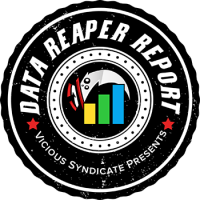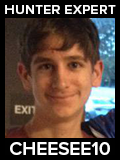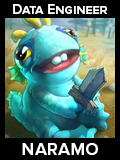
Welcome to the 170th edition of the Data Reaper Report! This is the first report for Scholomance Academy.
Contributing to the Data Reaper project through Hearthstone Deck Tracker or Firestone allows us to perform our analyses and to issue the weekly reports, so we want to wholeheartedly thank our contributors. Without the community’s contributions, there would be no project. Contributing data is very easy, so if you enjoy our content and would like to make sure it remains consistent and free – Sign up!
Quick Links
Class/Archetype Distribution | Class Frequency | Matchup Winrates | vS Power Rankings | vS Meta Score | Class Analysis & Decklists | Meta Breaker of the Week | How to Contribute | Credits
Important Messages: Don’t Skip!
- We’ve now added a rank bracket for top 1k legend, which we’re separating from legend rank in order to observe the meta at higher levels of play. This was possible due to the boost in our data collection thanks to Firestone. Every Firestone user automatically contributes data to the Data Reaper, with no other action required (there’s an opt-out option, we’re not forcing anyone to contribute!).
- If you contribute data to us through the HDT plugin, check to make sure it’s still enabled. With every new expansion or major patch, there’s always a risk of your HDT plugin being erroneously disabled without your knowledge.
- While Top 1k legend makes up a small % of the player base, it is usually where meta trends are first observed, so it has important implications for the rest of ladder. This is why we disproportionally value the meta at higher levels of play in our analysis. It’s often looking into the future, but not always!
- This is a reminder that all the graphs that are shown in this report are embedded screenshots of the original Tableau files. Every Tableau file, including data from every rank bracket, can be found by either clicking on the embedded image in the report, the quick links at the top of this report, or through the website’s navigation bar as follows:


Number of Games
| Overall | 235,000 |
| Top 1K Legend | 10,000 |
| Legend (Excluding Top 1k) | 20,000 |
| Diamond 4 to 1 | 40,000 |
| Diamond 10 to 5 | 60,000 |
| Platinum | 35,000 |
| Bronze/Silver/Gold | 70,000 |
Class/Archetype Distribution
[TABS_PRO id=41576]
Class Frequency
[TABS_PRO id=41636]
Class Frequency Discussion
This report is probably the most hectic one we’ve ever made, discussing merely the first 5 days of an expansion. More than ever, it’s important to read the report rather than just look at the numbers. We need to evaluate the development of each archetype, how diverse it is, and how close it is to be optimized. The data shown today may look very different in a couple of weeks.
Druid is the most popular class at every rank bracket. At higher levels of play, it dwarfs every other class in its representation. Guardian Animals Druid is everywhere, with the large majority of builds running Kael’thas and Survival of the Fittest. This deck is shaping the meta like no other deck, forcing classes to either deal with it, or be cast aside. There is a small percentage of Malygos Guardian Druid in development, and a modest share of Aggro Gibberling Druid.
Paladin is another class that started strong, peaking in popularity on the climb to legend, though noticeably becoming less popular as you climb through legend. Pure Paladin is all the rage after incorporating many of the powerful cards that the class received in this set. There is a slight divergence in its builds, but the deck has been fairly solidified.
Aggro Rogue is extremely diverse, as many different variants are seeing experimentation with Secret Passage, and they have a wide spectrum of win rates. The archetype is far from figured out, with mainly three different approaches displaying some overlap between them. In addition, we can see Galakrond Rogue, which is also split into different variants (Secret, Stealth, Vanilla). Finally, there are Thief/Burgle Rogues lurking around: both Quest builds and Questless builds.
Mage is another class that’s seeing a lot of experimentation. Fireworks Mage is a Mozaki OTK Combo deck that was built by Hunterace and feels similar in playstyle to Freeze Mage, but uses Arcane Missiles as a key finishing card. Cyclone Mage has made its return with Mana Giant builds being the most prominent, but nothing else about this deck is truly set in stone: it’s very much in its diapers when it comes to its refinement. Highlander Mage might be the most recognized archetype of the three and is fairly solidified in its builds, but there is already something brewing that could alter the deck’s playstyle, either slightly or dramatically so.
Priest has been quite prominent throughout all levels of play. It is mostly split between Highlander Priest and Galakrond Priest. Highlander Priest is fairly solidified in its build, with some small iterations. Galakrond Priest is in a much more chaotic state, with players currently failing to agree on the best direction for the archetype (Dragon, Vanilla, and others). Inner Fire Priest popped up in the first couple of days of Scholomance but faded away since.
Demon Hunter is still dominated by its aggressive archetype, with just a small number of Control Demon Hunters incorporating the Soul Fragment package. Aggro Demon Hunter is at an intermediate stage of its refinement, where the best direction was likely found, but underperforming builds still exist in significant numbers.
Warrior is surprisingly uncommon. More surprisingly, it is Big Warrior that is the most popular archetype of the class! Even at top legend, which is the habitat of many Enrage Warrior fanatics, the deck’s play rate is low, which might be the result of Guardian Druid’s overwhelming presence. Control Warrior can also be seen, with a small subset of Bomb Warrior that is very unexplored.
Warlock displays four distinct archetypes. Zoo Warlock is the most popular one, with Masochistic Flesh Giant builds making up the most of it. Galakrond Control Warlock is beginning to pop up, experimenting with two main packages (Dragons and Soul Fragments). Handlock and Quest Warlock are fading away, seemingly failing to capitalize on the potential of Flesh Giant.
Shaman is struggling to make an impact in the new meta. Most of its archetypes are fading away after failing to make a lasting impression. Totem Shaman is the only deck that looks fleshed out, but its play rate doesn’t infuse us with optimism regarding the future of the class.
Hunter is the class that’s seen the least amount of experimentation with the launch of the new expansion, likely the result of an uninspiring set. However, Highlander and Face Hunter are the familiar faces that can still be found. Both archetypes are figuring out how to incorporate new cards into their builds, and since they don’t see much play, the process is relatively slow (unless you just netdecked our Highlander Hunter list. That’s just smart).
[TABS_PRO id=41637]

[TABS_PRO id=41638]
vS Meta Score
[TABS_PRO id=41639]
vS Power Rankings Discussion
There are many interesting results, so let’s dive into the data analysis behind them. It’s difficult to build a story when there are so many moving parts and the meta is very young, so we’ll try to focus on each class and the potential we see in it.
- Paladin:
- Pure Paladin is the best performing deck in the format, and was tearing up ladder at every level of play in the first few days of the expansion. We will note that the deck’s win rate is currently trending down, especially at top legend, which is indicative of the meta starting to catch up to it as other decks are slowly becoming more efficient. We wouldn’t be surprised to see a more competitive Power Rankings table next week. Pure Paladin is certainly a powerful front-runner but it’s not as crazy as Galakrond Shaman or Aggro Demon Hunter.
- Murloc Paladin is uncommon, and doesn’t even utilize any new cards from the expansion, It looks like a solid Tier 2 deck based on our low sample estimates.
- Druid
- Guardian Druid has dictated the early Scholomance meta in a way no other deck has. The Scholomance meta feels extremely fast largely because decks are forced to win before the “7 mana turn.” Every other class is becoming entirely focused on beating Druid, yet its matchup spread only displays a few soft counters while its win rate rises further at top legend where Pure Paladin (its biggest counter) is less common. Power level wise, it looks “balanced”, but when you dig into the deck and search where the power is concentrated at, you find a new Imprisoned Scrap Imp.
- The Malygos variant looks inferior to the Survival/Kael’thas build. It has the potential to improve, especially if Priest and Mage rise in popularity, but as of today, it’s clearly behind.
- Gibberling Druid is unlikely to survive the rising efficiency from decks. It has little scope for improvement, so we can see it eventually slipping to the bottom tier and disappearing.
- Priest
- Highlander Priest looks nuts. Much of it has to do with how well the archetype performs against both Pure Paladin and Guardian Druid, with these matchups improving at higher levels. The plethora of removal available to it alongside Zephrys are important in answering the oppressive Druid boards you often have to face.
- Having said that, we’re not actually sure whether Highlander Priest is better than Galakrond Priest. Highlander Priest’s build has been fairly easy to refine and hit close to the optimal level, but Galakrond Priest has been experimenting with some serious garbage that has knocked its win rate down. We believe that a properly built Galakrond Priest could be just as strong, if not stronger, than Highlander Priest.
- Inner Fire Priest looks like a failed experiment. Low scope for improvement alongside an already low win rate is indicative of a dying archetype.
- Mage
- Highlander Mage is heavily slept on and ignored, likely because it’s not new and most of the focus within the class has been on other decks. Depending on how the meta further develops, it’s possible that Highlander Mage develops an edge against both Pure Paladin and Guardian Druid. Its matchup spread is incredible, and its primary weakness (Hunter) is fairly uncommon. One of the strongest choices on ladder at the moment.
- Don’t be fooled by Cyclone Mage’s current win rate. The deck has massive potential and could see its win rate rapidly shoot up once its optimal build is found and spread. We were close in our theorycrafting of the deck, which ended up being the foundation of other iterations, but there are some critical pieces for the current meta that are missing. Give it some time.
- Fireworks Mage got a lot of hype in the early days of Scholomance, but goodness gracious, it just looks atrocious! A win rate that’s under 40% is something even the biggest meme decks couldn’t accomplish, and it doesn’t get much better at higher levels. Stick to Cyclone for the miracle plays.
- Rogue
- Aggro Rogue’s average win rate is a result of its heavy experimentation. It’s an even bigger enigma than Cyclone Mage when it comes to figuring out its best build. The key is improving the Druid and Paladin matchups, which is certainly possible in theory, and we have an extensive discussion on how to achieve that. The All-In Voracious Reader builds are certainly not the way to go.
- Galakrond Rogue looks fairly mediocre and we’re not sure it has a place in a Guardian Druid meta. Its game plan is just too slow when the most popular deck in the format can do the things it does as early as turn 4-5. That matchup is pretty bad.
- Similarly, Thief Rogue suffers from its lack of urgency and lethality. However, there is a Questing Adventurer build centered on the Vendetta package that looks promising against Druid. If we take out the burgling, and add a few efficient and deadly cards, could we have a brand new and successful Miracle Rogue?
- Warlock
- Both Control Warlock and Zoo Warlock display potential that is either competitive or meta breaking. Zoo Warlock has room to grow through its Masochist build by cleaning up a few cards, perhaps giving it a few extra percentages against Druids and Paladins.
- Galakrond Control Warlock carries the perfect tool to deal with the two most popular decks in the format. Plague of Flames allows you to deal with overwhelming boards for little mana (much like how Priest does it). If it can overcome a few key questions regarding its optimal build, it could be another game-changer. To some degree, it already should be one.
- Demon Hunter
- Aggro Demon Hunter has seen its win rate suffer due to the propagation of a Glide build in the early days of the expansion. Glide is so damaging to the deck’s performance that its scope for improvement remains high, even when its optimal build is close to being figured out. You’ve got a Tier 4 build polluting an archetype that is much closer to Tier 1 in reality.
- Control Demon Hunter is also suffering from a similar problem: too many meme builds that are nowhere near competitive. The problem is that even if the archetype was entirely “clean”, it would still have an issue with Druid and Paladin. Demon Hunter’s lack of single target removal is a problem in the current meta, and it can’t really afford to play it slow for that reason.
- Warrior
- Big Warrior is surprisingly strong and effective against Druid, but we’re not ready to get on the hype train for this one. The deck has one of the lowest scopes for improvement, so when other decks become more efficient, it’s expected to drop in its win rate. Nevertheless, it’s a refreshing deck for the Warrior class that currently looks like the strongest one on ladder thanks to its Druid matchup.
- Enrage Warrior is massively struggling against Guardian Druid. Lord Barov alone is not enough to overcome the nonsense that Malfurion is capable of dishing out, and the deck isn’t quick enough to kill Druids before we reach the dreaded turn 7. We will say that most players are likely running the incorrect build for the current meta, so we anticipate that Enrage Warrior will get better in some matchups.
- Control Warrior is similarly struggling. The only way for a more defensive Warrior deck to succeed in the current meta is by running the Bomb package to pressure the opponents in a proactive fashion. We suspect that we’ll have more to say about Bomb Warrior next week.
- Hunter
- Even though it’s been out of the spotlight, Highlander Hunter is most certainly very competitive and successful. Players might be wary of its Druid/Paladin matchups, but it’s one of the strongest counters to Priest and also fares very well against Mage. Though its internal scope for improvement is low, it could benefit from some possible changes in the meta.
- Face Hunter is doing reasonably well, but the deck will have to drastically change its philosophy if it wants to perform optimally in the current meta. This means cutting uncuttable cards.
- Shaman
- The hapless Shaman is two blocks away from the neighborhood dumpster. Though Totem Shaman is displaying a reasonably competitive win rate, it’s trending down rapidly. Unless it finds an unlikely breakthrough, it will be in big trouble. Other archetypes of the class look fairly hopeless, so this might be all we have.
Class Analysis & Decklists
Demon Hunter | Druid | Hunter | Mage | Paladin | Priest | Rogue | Shaman | Warlock | Warrior
Druid might not look like the most powerful class on paper, but it’s certainly the most meta-defining class in practice. The “combo” of Overgrowth into Guardian Animals is so powerful that it has essentially made obsolete any deck that is incapable of dealing with it. As you will quickly understand from other classes’ sections, every deck in the current meta is heavily influenced by Guardian Druid in its card choices. You’re either able to answer an early GA through reactive means, or you’re able to produce enough pressure (or outright kill the Druid) before GA arrives to prevent it from becoming a game-winning play.
Guardian Druid has been refined relatively quickly in the first couple of days of the expansion since its best build is all about enhancing its 7 mana turn. We cannot overstate how much of the deck’s power is concentrated on Overgrowth and Guardian Animals. We think Wild Growth is not even good enough. Keeping it in your opening hand is too slow when going first, and only tolerable with the coin if it sets up a follow-up Overgrowth.
You’re better off running two copies of Overflow, which is a critical card for the deck’s game plan. Running one copy doesn’t seem to be correct. You always want to do something powerful once you hit 7 mana, and Overflow significantly improves your Kael’thas combo by allowing you to chain multiple procs in one turn more consistently.
An alternative Malygos version of Guardian Druid is also being explored. While it is stronger against Priest and Mage, it is worse against nearly every other class and is far more vulnerable to aggressive decks. We’ll have to see how the meta develops in order to figure out whether it could serve a significant role.
Gibberling Druid hasn’t hit the same heights. It’s clear that Gibberling is an extremely powerful card in aggressive Druid decks, but the shell’s overall card quality is still too low. Too heavy to carry.
Pure Paladin has arrived in a blaze of glory, and the new additions to the deck elevated it to the very top of the meta. First Day of School, Argent Braggart, Goody Two Shields, Devout Pupil, and Alura can be best described with a chef’s kiss.
Pure Paladin is mostly split between two approaches: The first is a more standard build that runs “the good cards.” The second attempts to abuse Alura and Argent Braggart harder by cutting Libram of Justice/Consecration for Blessing of Kings/Authority.
We’ve found that the second approach is not actually better against Druid, since Libram of Justice is a critical card in this matchup, and cutting it pigeonholes the Paladin into succeeding in its initial onslaught. It’s a sidegrade move against Druid, which means the first approach is stronger due to the importance of our comeback cards in other matchups. Consecration is far too important against Aggro Demon Hunter, which is one of our most difficult matchups, for example.
The featured build attempts to strike a balance between Paladin’s desire for aggression and a more well-rounded game plan that allows you to come back after falling behind. Shotbot is stronger than Murgur since the Prime is almost never relevant, and the mech is a far better play on turn 2 (which the deck needs). Two copies of Blessing of Authority are a bit too extreme, but one is a reasonable inclusion. Lightforged Crusader and Lady Liadrin provide you with longevity. You will face an enormous struggle against Priest without them.
Rogue has been experimenting with many different cards and packages, so this will be a long section. Aggro Rogue has emerged thanks to the raw power of Secret Passage, which we can now confidently claim to be the class’ strongest card in the set.
The question is, how do we build Aggro Rogue for the current meta? One approach has been unrelenting aggression through Voracious Reader. But this path has proven to be very weak, one-dimensional and doesn’t leave the Rogue with any room for flexibility.
Another approach has been running the Steeldancer package with Self-Sharpening Sword and Vulpera Toxinblade. This variant performs quite well, especially against Priests, and we’re featuring a ‘Stealth Dancer’ list which has been refined by J_Alexander (but we added Lilian). This variant does have one major issue in the current meta: it’s not fast enough to beat Druid.
A promising approach can be found in expanded Stealth builds, which are capable of dishing damage quickly but are sustainable through Greyheart Sage and a balanced curve. We crafted the featured build based on the performance of cards in the archetype. One potential sleeper in the deck is Burrowing Scorpid, which is particularly insane in any aggressive mirror, but strong overall. Expanding the stealth package significantly improves Ashtongue Slayer, a card that has been difficult to make work before.
Sinister Strike, Deadly Poison, Cold Blood, and Southsea Deckhand are cheap damage sources that synergize with Secret Passage. Both Lilian and Jandice are proven powerhouses in every Rogue archetype, so we’re quite confident they will do well here.
But Aggro Rogue isn’t the only way for the class to succeed in the current meta. We’ve found that Questing Adventurer can offer a strong foundation to tackle Druid in Miracle Rogue. We crafted the featured build based on our analysis of Thief Rogue builds running the Vendetta package. We’re not impressed with the Vendetta package due to its inability to close games consistently, so we’re trying to surround Questing Adventurers with a more ‘lethal’ shell.
We value the Secret package very highly in every Rogue deck that doesn’t play extremely aggressively in the current meta, because Blackjack Stunners provide important answers to both Druid and Paladin in the late game. Ironbark and Libram of Hope force us to run Sap (non-damage based removal) in non-secret builds, and Stunner is a much more powerful version of Sap.
We like running six secrets in a fast list since we need our Hanar and Stunners to be online early (they’re too weak when we run four secrets). It also helps to have more secrets available to Prep with Questing Adventurer. Because Bamboozle conflicts with QA, we’re content with Plagiarize. It can be surprisingly effective since many decks have certain power spikes you can anticipate, and it’s nice against opponents that are holding the coin. We’ll see how it performs in the future when players are aware it is being played.
We finish with value 1-drops, Pharaoh Cat and Wand Thief, which are strong Shadowstep targets (Spymistress isn’t very good in this kind of deck) and our two mid-game legendaries: Lilian and Jandice are just too good.
Galakrond Rogue has been around, though it hasn’t seen too much development. The problem with this archetype is that it’s too slow to get off the ground. Decks that require a lot of time to reach their power spikes are often overwhelmed by Druid, so we’re not big fans at the moment. The strongest build is likely secret-based (for reasons we’ve already mentioned), and we’re featuring Meati’s version, which is built fairly well. Polkelt seems to be a strong inclusion in the deck so far.
Mage has been an enigma and might be the class that’s furthest away from discovering what it can or cannot do. It will likely take another report for us to be fully confident of our assessments, but we already have leads on where to take the class.
Firstly, the combo Fireworks Mage centered around Mozaki looks very weak and is unlikely to stand the test of time. The deck wins in a very flashy way, but doesn’t seem to do it often. In addition, its performance is atrocious at all levels of play, and there is no indication it’s better than terrible “at the hands of the best players”. We’d stay away from this one.
Cyclone Mage has been experimenting with many different cards and win conditions, and no card seems to be safe. Even Mana Cyclone has been questioned by some players, though the card might be a little misunderstood in the current meta. It’s a strong late game card and an important enabler of Mana Giants, but it’s very risky to keep it in your opening hand with the intention of playing it early. Unless you have the nuttiest Sorcerer’s Apprentice hand alongside it, be wary.
A card we’re certain of is Devolving Missiles. It’s one of the class’ most powerful tools in the current meta, and a crucial answer to Druids and Paladins specifically. Run two copies, without question.
This leaves us with the deck’s win conditions. Chenvaala has been questioned due to its intense need for resources, but as an unignorable 3-drop with 5 health, its floor is still reasonable. Ras Frostwhisper is very powerful in faster matchups, where he can completely take over the board and close games. Jandice Barov shines in slower matchups, like Priest. Despite running Mana Giants, we’re not too fond of Conjurer’s Calling due to how reliant it is on drawing our two giants. It could be a 1-of, at most.
Highlander Mage has received almost no attention, yet it is currently the best performing Mage deck. Jandice Barov, Ras Frostwhisper and Devolving Missiles have become three of the deck’s very best cards. We’re featuring a list pioneered by Ox that runs cheap spells and Firebrand. We could even envision cutting the Big-Spell package in its entirety, though we can’t construct an alternative build with the data we possess. It would require us to seek an alternative win condition for late-game matchups. Could it be Tony’s time? Cobalt Spellkin? Food for thought.
Priest has exceeded all expectations and looks like a top tier class that is perfectly positioned for the emerging meta. The key to Priest’s success is its ability to withstand Druids. With its cheap, high impact removal, it can outlast the Druid’s ramping aggression despite having less mana available to do it.
Highlander Priest has been the standout performer for the class in the early days of Scholomance Academy, which makes some sense considering it’s been easier to build, with Zephrys serving as an extra big removal card to deal with Druid’s oppressive boards.
We really like maximizing our “Yoink” potential with the Cabal package. Cabal Acolyte is one of Priest’s most powerful cards, and we want it to be active consistently with the addition of Lazul’s Scheme. Cabal Shadow Priest makes sure Lazul’s Scheme and Wave of Apathy have more applications so that we always carry the threat of a game-ending swing. To make room for Scheme, we cut Shadow Madness, which is our weakest removal.
Galakrond Priest has been more difficult to refine, and will probably take more time. Time Rip is our strongest invoke outside of Disciple, and we need at least four invokes to justify running Fate Weaver. We think this build is likely better than the dragon variants we’ve seen in the early days of the expansion, but we’re not 100% sure (still early).
This build is different from AOO Galakrond Priest, since we don’t rely on generating value from our opponent’s deck. Our win condition in slower matchups is very often a Wave/Acolyte play, which can be absolutely crippling when stealing a big minion from it. We also have “card draw” through Raise Dead, making this deck far more consistent and less reliant on random garbage to close out games.
The final boss in every Priest deck is Illucia, and there’s something to be learned on how to use her well. She’s strong in the late game but she might be overvalued early. Using her to stall the opponent on turn 2 is generally a low percentage play (though it can be correct in some situations and matchups, like most things in Hearthstone). Use Illucia to waste your opponents’ key pieces in the late game, and she will often make you happy… and your opponent unhappy.
Inner Fire Priest has also been around but hasn’t produced great results. It does fairly well against Druid but crumbles against Paladins while also struggling against slower Priest and Mage decks. It might not have quite the critical mass of cards to be competitive, but it’s gotten closer.
Aggro Demon Hunter had a slow start early on, but has plenty of room to grow and get stronger considering its good matchup against Pure Paladin. Refining the archetype should also be fairly easy.
First, Glide sucks. A lot. The archetype’s win rate was hurt badly by an early build that ran this card, and it wasn’t pretty. Voracious Reader is a far stronger card draw engine that also works better with Skull of Gul’dan, which you still want in the deck.
In the current meta, we like the option of lowering the curve. Intrepid Initiate is a very strong 1-drop alongside Twin Slice, Demon Companion, and Mana Burn, the latter being very impactful against Druids. Marrowslicer is good enough in the deck as just a 4 mana 4/2 weapon with no other synergies. The upside of 8 damage and an activator for Glaivebound Adept on curve is too good to pass up.
Cards that are cut from the list are Amani Berserker and Satyr Overseer. We could see them replacing Initiate and Mana Burn, so it’s a very close call. Overseer conflicts with Marrowslicer and doesn’t work too well with Voracious Reader, but it could become stronger should the meta slow down.
Control Demon Hunter is littered with some of the worst builds you could imagine, but the build we theorycrafted last week is actually much better than current aggregated stats suggest for the archetype. Nevertheless, this deck does have an issue with Paladins, a matchup that exposes Demon Hunter’s lack of single target removal. The build is very promising against most other classes, so if we ever see Druid and Paladin weakened at some point in the future, watch out for this one!
Even though we did like Big Warrior’s potential before the expansion, we never expected it to become the best Warrior deck in Scholomance Academy. But that is the reality imposed by the overwhelming influence of Guardian Druid. While Big Warrior is one of the only decks that is capable of beating it consistently, Enrage and Control Warrior crumble to Malfurion’s mana cheating antics and Anduin’s…. antics in general.
Big Warrior’s build is relatively straightforward. One card we definitely underestimated is Athletic Studies, which offers the deck serviceable early game removal. Coerce is an important single target removal against both Druids and Paladins, while Bulwark of Azzinoth provides us with stalling.
Enrage Warrior is getting demolished by Druids, Paladins, and Priests. We think the deck could benefit from running double Kor’kron in the current meta while dropping the eggs. The Priest matchup is completely different with this adjustment, and much closer when you max out the chargers (the Paladin matchup improves as well). We also like Doctor Krastinov, as a replacement for Captain Greenskin in providing us with more damage and reach. Lord Barov is essential if we want to have any chance of beating Druid.
Control Warrior is weighed down by underperforming builds piloted by players who seem to think removal is a good game plan in this meta. Since we would like to have a win rate that is higher than 10% against Priests, bombs are the only way, and we think Bomb Warrior could have potential. We’re featuring a build that was prepared for this week’s Grandmaster matches by Casie and Bunnyhoppor, where Bomb Warrior is a very popular choice. This build is particularly spicy, with the primary game plan revolving around a never-ending Wrenchcalibur. Hopefully, the archetype will now see more play and give us a chance to evaluate its card choices more extensively.
Both Handlock and Questlock, which were hyped up with the introduction of Flesh Giant, ended up whimpering their way out of the Scholomance meta. Instead, it was Zoo Warlock who looked to capitalize on the potentially meta defining card by hurting itself, a lot.
Indeed, the Masochist Zoo Warlock has the potential to exhibit favorables against the dominant Guardian Druid and Pure Paladin. Brittlebone Destroyer is key in these matchups, and it’s currently not close to being as common as it should be: 2-of in every list. The trap card in the deck is Neferset Thrasher, while Imprisoned Scrap Imp is also not the best fit.
But there is another Warlock deck with even greater meta breaking potential, and that is Galakrond Control Warlock. Plague of Flames allows you to deal with the most oppressive Druid boards. Our featured build is likely the strongest direction for the archetype, which involves cutting the dragon package for the soul fragment package in its entirety. We still have great AOE and single target removal, though our healing is now incremental. The issue with the dragon package is the difficulty of fitting in good dragons to make our Nether Breath and Crazed Netherwing consistent.
Shaman might be the weakest class in the format. Most of its archetypes have failed to make a mark, including the much-hyped Spell Damage Shaman. The only Shaman deck that currently looks competitive is Totem Shaman, but even this deck is hardly looking impressive.
Figuring out the best Totem Shaman build leads to some surprising results. We’re disappointed that Trick Totem looks like a very weak card that’s not even good enough to play in a Totem Shaman deck. The average outcome of Trick Totem is not strong enough to offset the tempo loss of a 2 mana 0/3.
Good cards in the deck are Devolving Missiles (you should know why by now) and Torrent, which combos well with Notetaker. Bloodlust is back in the list because this deck’s finishing potential is not quite there.
Overall, Shaman is in a sad state of affairs. With several aggressive decks potentially becoming more efficient, Shaman’s position in the meta could get worse over time. We’re not even sure that balance changes will make things better, considering that Guardian Druid is one of Totem Shaman’s reasonable matchups.
It’s been a boring launch of the expansion for Hunter, as its set has predictably failed to support the emergence of a new archetype. The good news is that Highlander Hunter is quietly doing very well in the current meta, which admittedly could change considering the scope for improvement that we see in other classes.
The addition of several impactful 1-mana plays has boosted Hunter’s early game, while Polkelt allows us to find Dinotamer Brann to close out games late. The build is performing very well, with one piece of advice: get greedy in your mulligan because you can afford to, so don’t settle for a 3-drop (you have plenty of them) when you don’t have an earlier play.
We can identify several decks that could end up reshaping the current field. We particularly like the potential of Mage and Warlock when attempting to find an answer to the currently meta defining Guardian Druid and Pure Paladin.
However, this week’s Meta Breaker title has to be given to Anduin. After all, we wouldn’t be able to poke fun at ourselves for ranking Priest 10th in our expansion preview if we didn’t give it to Anduin. Or maybe, we should give it to Illucia.
In short, Priest has the necessary ingredients to withstand some of the most ridiculous plays in the format. It is a class well equipped to either remove an overwhelming amount of stats, or steal it thanks to the power of Wave of Apathy/Cabal Acolyte, or prevent it from happening thanks to Illucia, or just prevent you from ever having fun in this game.
In short, Priest is in a great position to make everyone else miserable. The only question is, can we make Priest equally miserable in return?
Preparing our weekly article requires a significant amount of time and effort from many individuals. We would like to wholeheartedly thank our current Patreons, whose generous donations help us fund computing and server costs.
vS Gold is a new membership plan aimed to support our efforts towards improving our content and data analysis while receiving some bonuses and extra features.
Tier 3+ Patrons
Special thanks to Leo G, Aaron B, Jed M, Drew M, Alan J, Zolstar, Sean H, Steve F, Andrew N, NObdy, Alonso P, James Y, Je-ho, Ziqiao Y, Stephen H, William H, Patrick L, 1RiceBowl1, Alex S, PeejTreon, Dunks406, Josh G, Sam, James C, Matthew H, Bruno B, and Amir for supporting us this month.
Contributors
Here are all the people that participated in bringing you this edition of the vS Data Reaper Report:
































I am experimenting a Highlander priest deck without the Galakrond package and I find it quite strong. I am wondering if there is any data on this deck, just to know if it is better (or not) than the list you provided.
BTW thanks a lot for your work!
Nerfs not nerds! Bloody phone autocorrect
Is it just me or does weapon Rogue really feel like the DH of Scholomance Academy? And I don’t mean the cards one by one but the whole tempo and game plan in general. Nicely curved out minions and weapons, cheap card draw (even better imo than a 6 mana, even with discounts or spectral, both of them needing the outcast to be worth), cheap high dmg minions that can also be used for trading (especially with stealth protecting them without buffs and providing also refusals with spymistress being one of the strongest 1 mana drops in game), minions with synergies, 2-3 very strong legendaries for reach and board swing, a weapon with unique mechanism and weapon hero power. Of course the hp is not 1 mana but it stays for 2 turns carrying any buff to the next one. A neutral taunt, no Kayn effect but sap(s) for final bypass (or getting rid of crazy buffed minions), 3 minions that generate board stats, evisc better than current meta. All in all seems similar game plan without aoe reach. (not referring to healing as it started declining anyway in aggro DH builds)
Just honest, tempo, synergetic cards. Fun! Rogue being fun again. Without the crazy, annoying, unstable card generations. Having already your own good cards. You know what to expect but it’s fun and refreshing. That’s what DH was as well before being butchered and more than half of the cards in deck became neutral ones. It wasn’t DH that needed nerf but other classes needing a buff and a new approach from blizzard.
And tbh, people are looking in the wrong direction when they ask for nerds atm. Yes maybe lightning bloom/GA/overgrowth, Illucia, mainly because of game experience or maybe zealot or if people manage to abuse Alura, but I think that the best class in this expansion that will soon rise to the top is rogue.
I love the class atm and I would be sad to see nerfs but being honest, passage needs a toning down (I hope they don’t kill it by changing mana, but maybe 4 cards draw?) and I think that Jandice is the best legendary so far. Can put too many stats on the board for 5 mana.
And please, stop the miracle hype! We understand your love for it but you should stay neutral 😉
Don’t urge the meta towards random generation rogues again. The miracle is having fresh fun cards at last after so long. And rogue players have experienced now how it feels to be on the other side and how frustrating that randomness is for both players.
The secret sauce for Gibberling Druid, in my experimentation, is to skip Lightning Bloom and include Soulbound Ashtongue. Bloom prevents you from following up with buffs or additional board presence – Ashtongue gives you an extremely strong presence that is impossible for most classes to immediately remove without a multi-card investment, snowballing into following turns, and its downside is negligible when you want to kill the opponent before they have a chance to react.